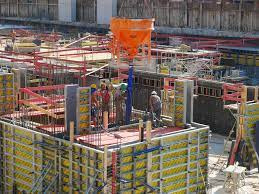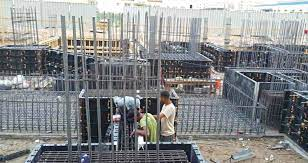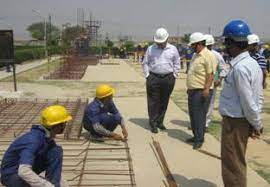Assistant Shuttering Carpenter (6 month course)
Assistant Shuttering Carpenter click here
Brief Job Description
Assistant shuttering carpenter is responsible for identification, handle and use of tools and tackles,
materials and equipment’s. The responsibilities also include use of power tools/equipment’s for cutting and sizing of timber and plywood, providing support in assembling and dismantling of conventional and system formwork for R.C.C structures to complete work within specified time and tolerance.

Personal Attributes
The individual is expected to be physically fit and able to work across various locations in withstanding
extreme conditions while working. The person should be able to work within a team to handle various
shuttering carpentry tools, materials, components and works under instructions and close supervision.
Use and maintain tools and equipment relevant to shuttering carpentry
Description
This unit describes the skills and knowledge required to use and maintain tools, components, equipment
and materials relevant to shuttering carpentry under instructions and close supervision
Scope
The scope covers the following :
Use and maintain tools, components, and equipment relevant to shuttering carpentry
Elements and Performance Criteria
Use and maintain tools, components, and equipments relevant to shuttering carpentry
To be competent, the user/individual on the job must be able to:
PC1. use hand tools such as claw hammer, hand saw, hack saw wooden planners, measuring tape,
nailing hammer, try square, plumb bob and other relevant tools
PC2. use power tools for cutting, planing and drilling of timber/plywood
PC3. use materials such as timbers, plywood, runner pieces of different size, wooden battens for
shuttering work
PC4. use consumable items such as nails of different size, masking tape, cotton waste, cotton and
nylon line thread in relevant to shuttering works
PC5. use personal protective gears such as safety shoes, gloves, helmets, ear plugs, nose mask,
safety goggles
PC6. identify and wear full and half body safety harness
PC7. use bamboos & ballis, props, acrow span, H-beam, shuttering sheets, foot plates, U head and
other relevant components for shuttering works
PC8. store, stack and shift shuttering components as per standard procedure
PC9. use different types of slings, shackles and lifting belts for lifting operation
PC10. maintain tidiness at site location
PC11. barricade area of work to prevent unauthorized entrance

Knowledge and Understanding (KU)
The individual on the job needs to know and understand:
KU1. safety rules and regulations for handling and storing shuttering and scaffolding tools,
materials and components
KU2. personal protection including use of safety gears and equipment
KU3. safe working methods and movements while performing relevant tasks
KU4. request procedure for tools & materials and equipment
KU5. housekeeping & other site administrative rules
KU6. use of hand tools such as claw hammer, hand saw, hack saw wooden planners, measuring
tape, nailing hammer, try square, plumb bob and other relevant tools
KU7. consumable materials and their optimum use
KU8. visual check for quality of timber and plywood
KU9. types of wood such as hard wood and soft wood and its common defect
KU10. types and thickness of plywood such as commercial , water proof, marine plywood
KU11. types and use of slings, shackles and lifting belts
KU12. height up to which each shuttering carpentry and scaffolding materials should be stacked
KU13. different types of hand and power tools used for cutting and planning of timber
KU14. stacking of various shuttering carpentry and scaffolding materials as per standard practices
KU15. various components and their standard sizes
KU16. workplace procedures and policies for manual and mechanical handling
KU17. standard procedure for housekeeping
KU18. storing and handling technique of tools
KU19. upkeep repair and maintenance of tools
KU20. how to work at heights
Generic Skills (GS)
User/individual on the job needs to know how to:
GS1. write in one or more language, preferably in the local language of the site
GS2. read in one or more language, preferably in the local language of the site
GS3. read instructions, guidelines, sign boards, safety rules & safety tags instructions related to
exit routes during emergency at the workplace
GS4. speak in one or more language, preferably in one of the local languages of the site
GS5. listen and follow instructions given by the superior
GS6. communicate orally and effectively communicate with team members
GS7. decide whether his workplace is safe for working and also his work is not creating hazardous
conditions for other
GS8. complete work as per agreed time schedule and quality
Assist in making wooden shutters boards using in shuttering carpentry
Description
This unit describes the skills and knowledge required to assist in making wooden shutters by cutting,
sizing, planning and drilling of timber, plywood using power tools/equipment and making timber joints

Scope
The scope covers the following :
Perform cutting, planning and drilling of timber, plywood using power tools/equipment and make
timber joints
Elements and Performance Criteria
Perform cutting, planning and drilling of timber, plywood using power tools/equipments and make timber
joints
To be competent, the user/individual on the job must be able to:
PC1. identify power tools such as hand held circular saw, hand held zig saw, hand drill machine,
table mounted saw, planning machine and power drilling machine
PC2. identify different types of wood & plywood
PC3. select circular saw blade based on thickness and type of wood to be cut
PC4. check cutting blade for its sharpness and bend
PC5. check wooden planning machine blade, auger drill bit for its sharpness
PC6. use measurement and marking tools for correct sizing of timber/plywood
PC7. use hand held power saw for cutting and sizing of timber and plywood
PC8. safely feed timber/ plywood to the table mounted saw
PC9. cut timber and plywood of different types and thickness using table mounted saw
PC10. use planing machine for planing of timber and finishing the rough surface
PC11. use power drilling machine for drilling different diameter hole in timber and plywood
PC12. make timber joint such as lap joint, mortis and tenon joints, dovetail joints and housing joints
using appropriate hand tools
PC13. assist in making shutter boards as per instructions
PC14. maintain tidiness at site location
PC15. follow standard safety measure while operating power tools
Knowledge and Understanding (KU)
The individual on the job needs to know and understand:
KU1. safety rules and regulations for handling and storing shuttering and scaffolding tools,
materials and components
KU2. personal protection including use of safety gears and equipments
KU3. safe working methods and movements while performing relevant tasks
KU4. request procedure for tools & materials and equipment
KU5. housekeeping & other site administrative rules
KU6. use of power tools such as hand held circular saw, hand held zig saw, hand drill machine,
table mounted saw, planning machine and power drilling machine
KU7. visual check for quality of timber and plywood
KU8. types of wood such as hard wood and soft wood and its common defect
KU9. types and thickness of plywood such as commercial , water proof, marine plywood
KU10. different types of hand and power tools used for cutting and planning of timber
KU11. standard procedure for housekeeping
KU12. knowledge about storing and handling technique of tools
KU13. knowledge about upkeep repair and maintenance of tools
KU14. use of measurement and marking tools
KU15. seasoning of timber, storage of timber to prevent decay distortion, bending, splitting and
timber treatments

KU16. various types of timber joints
KU17. use of various types of file
KU18. different types of cutting blade, size and cutting depth
KU19. use of personal protective gears for cutting and sizing operations
KU20. electrical safety for use of power tools
KU21. how to make line, sketch and label
Generic Skills (GS)
User/individual on the job needs to know how to:
GS1. write in one or more language, preferably in the local language of the site
GS2. read in one or more language, preferably in the local language of the site
GS3. read instructions, guidelines, sign boards, safety rules & safety tagsinstructions related to exit
routes during emergency at the workplace
GS4. speak in one or more language, preferably in one of the local languages of the site
GS5. listen and follow instructions given by the superior
GS6. communicate orally and effectively with team members
GS7. decide whether his workplace is safe for working and also his work is not creating hazardous
conditions for other
GS8. plan work & organize required resource in coordination with team member sand superior
GS9. complete work as per agreed time schedule and quality
Assist in assembling and dismantling conventional and system formwork for R.C.C structures
Description
This unit describes the skills and knowledge required to provide support in assembling and dismantling
conventional and system formwork for R.C.C structures under instructions and close supervision.

Scope
The scope covers the following :
Assemble and dismantle conventional formwork for R.C.C structures and provide necessary
assistance
Assemble and dismantle system formwork for R.C.C structures and provide necessary assistance
Elements and Performance Criteria
Assemble and dismantle conventional formwork for R.C.C structures and provide necessary assistance
To be competent, the user/individual on the job must be able to:
PC1. select tools and tackles, materials, components and equipment’s as per the instructions
PC2. shift and stack required quantity of materials, components at work place as per instructions
PC3. assist in marking, cutting and sizing of timber for making shutter boards
PC4. transfer level from reference points using water level tube
PC5. select bamboo, ballis based on height, diameter and thickness
PC6. ensure jute thread is kept in water before using it for tying of bamboo, balls
PC7. select , cut and size timber/ plywood of required size for making shutter boards
PC8. carry out nailing works in making of shutter boards as per instructions
PC9. assist in erecting staging for shuttering using conventional formwork
PC10. assist and place props at marked location as per instructions
PC11. assist and place shutter boards at specified location as per instructions
PC12. assist in aligning and providing support to shutter boards as per instructions using ballis,
wooden battens, pipes and props
PC13. assist in checking line, level and alignment and making corrective action if required
PC14. tie different types of knots effectively
PC15. follow method statement for sequence of task
PC16. assist in de-shuttering works for removal of shutter boards safely under instructions
PC17. follow standard safety procedure and housekeeping practices
Assemble and dismantle system formwork for R.C.C structures and provide necessary assistance
To be competent, the user/individual on the job must be able to:
PC18. select tools and tackles, materials, components and equipment as per instructions
PC19. shift and stack required quantity of materials, components at work place as per instructions
PC20. assist in marking, cutting and sizing of timber for making shutter boards
PC21. PC21. transfer level from reference points using water level tube
PC22. • PC22. select, cut and size timber/ plywood of required size for making shutter
• boards
PC23. carry out nailing works for making of shutter boards as per instructions
PC24. assist in assembling and fixing aluminum and steel formwork as per instructions
PC25. assist in erecting staging for shuttering using system formwork
PC26. assist, place and fix props at marked location as per instructions
PC27. assist and place shutter boards at specified location as per instructions
PC28. assist in aligning and providing support to shutter board as per instructions using standard
components
PC29. • assist in checking line, level and alignment and making corrective action if
• required
PC30. • assist in de-shuttering works for removal of shutter boards safely under
• instructions
PC31. follow standard safety procedure and housekeeping practices

Knowledge and Understanding (KU)
The individual on the job needs to know and understand:
KU1. safety rules and regulations for handling and storing shuttering and scaffolding tools,
materials and components
KU2. personal protection including use of safety gears and equipment’s
KU3. safe working methods and movements while performing relevant tasks
KU4. request procedure for tools & materials and equipment
KU5. housekeeping & other site administrative rules
KU6. units of measurements
KU7. use of measurements and marking tools
KU8. use of hand tools for carrying out shuttering works
KU9. standard size of hand tools
KU10. standard size of components
KU11. use of slings, shackles, and belts for lifting
KU12. use of water level tube, spirit level, plumb bob, tri-square
KU13. how to provide support in shuttering works
KU14. different types of tying thread
KU15. how to tie various types of knots and its use
KU16. use of materials, components and equipment’s for conventional and system formworks
KU17. different types of hand and power tools used for cutting and planning of timber
KU18. standard procedure for assembling and dismantling conventional and system formwork
KU19. knowledge about storing and handling technique of tools
KU20. knowledge about upkeep repair and maintenance of tools
KU21. use of personal protective gears
KU22. standard procedure for housekeeping
Generic Skills (GS)
User/individual on the job needs to know how to:
GS1. write in one or more language, preferably in the local language of the site
GS2. read in one or more language, preferably in the local language of the site
GS3. read instructions, guidelines, sign boards, safety rules & safety tags instructions related to
exit routes during emergency at the workplace
GS4. speak in one or more language, preferably in one of the local languages of the site
GS5. listen and follow instructions given by the superior
GS6. communicate orally and effectively with team members
GS7. decide whether his workplace is safe for working and also his work is not creating hazardous
conditions for other
GS8. plan work & organize required resource in coordination with team members and superior
GS9. complete work as per agreed time schedule and quality
Erect and dismantle temporary scaffold up to 3.6 meter height
Description
This unit describes the skills and knowledge required to erect and dismantle 3.6 meter temporary scaffold
Scope
The scope covers the following :
Erect and dismantle temporary scaffold up to 3.6 meter height
Elements and Performance Criteria
• Erect and dismantle temporary scaffold up to 3.6 meter height
To be competent, the user/individual on the job must be able to:
PC1. level area where scaffold need to be erected and check for ground compactness if required
PC2. shift and stack required materials, components, tools and tackles at the instructed location
PC3. wear and use required safety gadgets and follow trade safety
PC4. place base plates and sole boards on the ground as per markings and instructions
PC5. use proper components and follow standard procedure for erecting temporary scaffold up to 3.6 m
PC6. check verticality of scaffold at first level of erection and correct (if required) before moving to
the next level

PC7. check for rigidity, stability and support of erected scaffold
PC8. fix walk-boards, guard rails, toe-boards and other components on working platform
PC9. follow standard procedure for dismantling of 3.6 m temporary scaffold
PC10. remove guard rails, toe boards, walk boards and other components sequentially
PC11. clean and stack all components properly after dismantling
PC12. maintain tidiness at work location
Knowledge and Understanding (KU)
The individual on the job needs to know and understand:
KU1. standard procedure for scaffolding works
KU2. safety rules and regulations for handling and storing scaffolding tools, materials and
components
KU3. personal protection including use of safety gears and equipment
KU4. safe working methods and movements while performing relevant tasks
KU5. request procedure for tools & materials
KU6. housekeeping & other administrative rules
KU7. use of different types of scaffolds (cup-lock , frame scaffold)
KU8. use of tools and tackles in scaffolding works
KU9. identification and use of different components
KU10. use of tools for measurements and marking
KU11. basic arithmetic calculation
KU12. units of measurements
KU13. standard size of scaffolding components
KU14. personal protective equipment for safety
KU15. importance of housekeeping
KU16. standard procedure for erection and dismantling of 3.6 m temporary scaffold
KU17. tools and equipment used for erecting and dismantling 3.6 meter temporary scaffoild
Generic Skills (GS)
User/individual on the job needs to know how to:
GS1. write in one or more language, preferably in the local language of the site
GS2. read one or more language, preferably the local language of the site
GS3. read instructions, guidelines, sign boards, safety rules & safety tags instruction related to
exit routes during emergency at the workplace
GS4. speak in one or more language, preferably in one of the local languages of site
GS5. listen and follow instructions / communication shared by superiors/ co- workers regarding
team requirements or interfaces during work processes
GS6. orally communicate with co-workers regarding support required to complete the respective
work
GS7. decide whether the workplace is safe for working and also whether the relevant work is not
creating hazardous conditions for others
GS8. identify and organize right scaffolding materials
GS9. identify and use relevant tools effectively
GS10. complete work as per agreed time and quality
GS11. minimize wastages
GS12. revert to superior for selection/sorting of materials
GS13. identify location at which violation of any safety norms may lead to accidents
Work effectively in a team to deliver desired results at the workplace
Description
This unit describes the skills and knowledge required to work effectively within a team to achieve the
desired results
Scope
The scope covers the following :
Interact and communicate effectively with co-workers, superiors and sub-ordinates across different
teams
Support co-workers, superiors and sub-ordinates within the team and across interfacing teams to
ensure effective execution of assigned task
Elements and Performance Criteria
Interact and communicate in effective and conclusive manner
To be competent, the user/individual on the job must be able to:
PC1. pass on work related information/ requirement clearly to the team members
PC2. inform co-workers and superiors about any kind of deviations from work
PC3. address the problems effectively and report if required to immediate supervisor appropriately
PC4. receive instructions clearly from superiors and respond effectively on the same
PC5. communicate to team members/subordinates for appropriate work technique and method
PC6. seek clarification and advice as per the requirement and applicability
Support co-workers to execute project requirements
To be competent, the user/individual on the job must be able to:
PC7. hand over the required material, tools tackles, equipment and work fronts timely to interfacing
teams
PC8. work together with co-workers in a synchronized manner
Knowledge and Understanding (KU)
The individual on the job needs to know and understand:
KU1. own roles and responsibilities
KU2. importance of effective communication and establishing strong working
KU3. risks of a failure in teamwork in terms of effects on project outcomes, timelines, safety at the
construction site, etc.
KU4. different modes of communication, and its appropriate usage
KU5. importance of creating healthy and cooperative work environment among the gangs of
workers
KU6. different activities within his work area where an interaction with other workers is required
KU7. applicable techniques of work, properties of materials used, tools and tackles used, safety
standards that co- workers might need as per the requirement
KU8. importance of proper and effective communication and the expected adverse
KU9. importance and need of supporting co-workers facing problems for smooth
Generic Skills (GS)
User/individual on the job needs to know how to:
GS1. write in at least one language, preferably in the local language of the site
GS2. read in one or more languages, preferably the local language of the site
GS3. read communication from team members regarding work completed, materials used, tools
and tackles used, support required
GS4. speak in one or more languages, preferably in one of the local language of the site
GS5. listen and follow instructions / communication shared by superiors/ co-workers regarding
team requirements or interfaces during work processes
GS6. orally communicate with co-workers regarding support required to complete the respective
work
GS7. decide on what information is to be shared with co-workers within the team or from
interfacing gang of workers
GS8. plan work and organize required resources in coordination with team members
GS9. complete all assigned task in coordination with team members
GS10. take initiative in resolving issues among co-workers or report the same to superiors
GS11. ensure best ways of coordination among team members
GS12. communicate with co-workers considering their educational / social background
GS13. evaluate the complexity of task and determine if any guidance is required from superiors
Work according to personal health, safety and environment protocol at construction site
Description
This NOS covers the skill and knowledge required for an individual to work according to personal health,
safety and environmental protocol at construction site
Scope
The scope covers the following :
Follow safety norms as defined by organization
Adopt healthy & safe work practices
Implement good housekeeping and environment protection process and activities
Elements and Performance Criteria
Follow safety norms as defined by organization
To be competent, the user/individual on the job must be able to:
PC1. identify and report any hazards, risks or breaches in site safety to the appropriate authority
PC2. follow emergency and evacuation procedures in case of accidents, fires, natural calamities
PC3. follow recommended safe practices in handling construction materials, including chemical
and hazardous material whenever applicable
PC4. participate in safety awareness programs like Tool Box Talks, safety demonstrations, mock
drills, conducted at site
PC5. select and operate different types of fire extinguishers corresponding to types of fires as per
EHS guideline
PC6. identify near miss , unsafe condition and unsafe act
Adopt healthy & safe work practices
To be competent, the user/individual on the job must be able to:
PC7. use appropriate Personal Protective Equipment (PPE) as per work requirements including:
Head Protection (Helmets), Ear protection Fall Protection, Foot Protection, Face and Eye
Protection, Hand and Body Protection, Respiratory Protection (if required)
PC8. handle all required tools, tackles , materials & equipment safely
PC9. follow safe disposal of waste, harmful and hazardous materials as per EHS guidelines
PC10. install and apply properly all safety equipment as instructed
PC11. follow safety protocol and practices as laid down by site EHS department
PC12. undertake and pass height pass test as per EHS guideline
Implement good housekeeping practices
To be competent, the user/individual on the job must be able to:
PC13. collect and deposit construction waste into identified containers before disposal, separate
containers that may be needed for disposal of toxic or hazardous wastes
PC14. apply ergonomic principles wherever required
Knowledge and Understanding (KU)
The individual on the job needs to know and understand:
KU1. reporting procedures in cases of breaches or hazards for site safety, accidents, and
emergency situations as per guidelines
KU2. types of safety hazards at construction sites
KU3. basic ergonomic principles as per applicability
KU4. the procedure for responding to accidents and other emergencies at site
KU5. use of appropriate personal protective equipment to be used based on various working
conditions
KU6. importance of handling tools, equipment and materials as per applicable
KU7. health and environments effect of construction materials as per applicability
KU8. various environmental protection methods as per applicability
KU9. storage of waste including the following at appropriate location: non-combustible scrap
material and debris, combustible scrap material and debris, general construction waste and
trash (non-toxic, non-hazardous), any other hazardous wastes and any other flammable
wastes
KU10. how to use hazardous material, in a safe and appropriate manner as per applicability
KU11. types of fire
KU12. procedure of operating different types of fire extinguishers
KU13. safety relevant to tools, tackles, & requirement as per applicability
KU14. housekeeping activities relevant to task
Generic Skills (GS)
User/individual on the job needs to know how to:
GS1. write in at least one language, preferably in the local language of the site
GS2. fill safety formats for near miss, unsafe conditions and safety suggestions
GS3. read in one or more language, preferably in the local language of the site
GS4. read sign boards, notice boards relevant to safety
GS5. speak in one or more language, preferably in one of the local language of the site
GS6. listen instructions / communication shared by site EHS and superiors regarding site safety,
and conducting tool box talk
GS7. communicate reporting of site conditions, hazards, accidents, etc.
GS8. not create unsafe conditions for others
GS9. keep the workplace clean and tidy
GS10. identify safety risks that affect the health, safety and environment for self and others
working in the vicinity, tackle it if within limit or report to appropriate authority
GS11. assess and analyze areas which may affect health, safety and environment protocol on the
site
GS12. ensure personal safety behavior GS13. respond to emergency







